Deck 10: Aggregate Supply
Question
Question
Question
Question
Question
Question
Question
Question
Question
Question
Question
Question
Question
Question
Question
Question
Question
Question
Question
Question
Question
Question
Question
Question
Question
Question
Question
Question
Question
Question
Question
Question
Question
Question
Question
Question
Question
Question
Question
Question
Question
Question
Question
Question
Question
Question
Question
Question
Question
Question
Question
Question
Question
Question
Question
Question
Question
Question
Question
Question
Question
Question
Question
Question
Question
Question
Question
Question
Question
Question
Question
Question
Question
Question
Question
Question
Question
Question
Question
Question

Unlock Deck
Sign up to unlock the cards in this deck!
Unlock Deck
Unlock Deck
1/150
Play
Full screen (f)
Deck 10: Aggregate Supply
1
Identify the correct statement.
A)In periods of low inflation,real wages are constant but nominal wages decline.
B)If the price level increases,real wages will increase.
C)If the price level increases,nominal wages will fall.
D)In periods of high inflation,real wages change even if nominal wages remain constant.
E)If the inflation rate is high,real wages and nominal wages change by the same amount.
A)In periods of low inflation,real wages are constant but nominal wages decline.
B)If the price level increases,real wages will increase.
C)If the price level increases,nominal wages will fall.
D)In periods of high inflation,real wages change even if nominal wages remain constant.
E)If the inflation rate is high,real wages and nominal wages change by the same amount.
In periods of high inflation,real wages change even if nominal wages remain constant.
2
If nominal wage rates increase by 2 percent per year and the price level increases by 5 percent per year,real wages will:
A)increase by 3 percent per year.
B)increase by 5 percent per year.
C)increase by 2 percent per year.
D)decrease by 5 percent per year.
E)decrease by 3 percent per year.
A)increase by 3 percent per year.
B)increase by 5 percent per year.
C)increase by 2 percent per year.
D)decrease by 5 percent per year.
E)decrease by 3 percent per year.
decrease by 3 percent per year.
3
The potential output of an economy is:
A)the output level at which inflation is very high.
B)the output level at which nominal GDP is equal to real GDP.
C)less than the full-employment rate of output.
D)the output level at which total unemployment is zero.
E)also referred to as the natural rate of output.
A)the output level at which inflation is very high.
B)the output level at which nominal GDP is equal to real GDP.
C)less than the full-employment rate of output.
D)the output level at which total unemployment is zero.
E)also referred to as the natural rate of output.
also referred to as the natural rate of output.
4
When the economy is at its potential output level,which of the following is true?
A)The price level is higher than that expected by workers.
B)The nominal wage is equal to the real wage.
C)The unemployment rate is about 14 percent.
D)The economy is producing its maximum sustainable output.
E)The actual price level is less than the expected price level.
A)The price level is higher than that expected by workers.
B)The nominal wage is equal to the real wage.
C)The unemployment rate is about 14 percent.
D)The economy is producing its maximum sustainable output.
E)The actual price level is less than the expected price level.

Unlock Deck
Unlock for access to all 150 flashcards in this deck.
Unlock Deck
k this deck
5
Which of the following is true?
A)The nominal wage will be constant only if the inflation rate is constant.
B)The real wage will be greater than the nominal wage only if the inflation rate is constant.
C)The nominal wage and the real wage will change by the same amount if the price level is constant.
D)The real wage will be equal to one only if the price level is zero.
E)The real wage will be constant only if the nominal wage is constant.
A)The nominal wage will be constant only if the inflation rate is constant.
B)The real wage will be greater than the nominal wage only if the inflation rate is constant.
C)The nominal wage and the real wage will change by the same amount if the price level is constant.
D)The real wage will be equal to one only if the price level is zero.
E)The real wage will be constant only if the nominal wage is constant.

Unlock Deck
Unlock for access to all 150 flashcards in this deck.
Unlock Deck
k this deck
6
A nominal wage is:
A)always equal to the legal minimum wage.
B)the same as the efficiency wage.
C)measured in terms of the amount of goods and services it can purchase.
D)measured in current dollars rather than in constant dollars.
E)measured in constant dollars rather than in current dollars.
A)always equal to the legal minimum wage.
B)the same as the efficiency wage.
C)measured in terms of the amount of goods and services it can purchase.
D)measured in current dollars rather than in constant dollars.
E)measured in constant dollars rather than in current dollars.

Unlock Deck
Unlock for access to all 150 flashcards in this deck.
Unlock Deck
k this deck
7
Suppose the price level increases by 5 percent and the nominal wages of workers increase by 3 percent during a particular year.This implies that the real wage has:
A)declined by 2 percent.
B)declined by 8 percent.
C)also increased by 2 percent.
D)also increased by 8 percent.
E)remained constant.
A)declined by 2 percent.
B)declined by 8 percent.
C)also increased by 2 percent.
D)also increased by 8 percent.
E)remained constant.

Unlock Deck
Unlock for access to all 150 flashcards in this deck.
Unlock Deck
k this deck
8
Which of the following is true of the short-run aggregate supply curve?
A)It shows the relation between the inflation rate and the quantity of aggregate output firms supply,other things constant.
B)It shows the relation between the price of labor and the aggregate quantity of labor workers supply,other things constant.
C)It shows the relation between the interest rate and the quantity of capital goods firms supply,other things constant.
D)It shows the relation between the price level and the quantity of aggregate output firms supply,other things constant.
E)It shows an inverse relationship between the price level and real GDP.
A)It shows the relation between the inflation rate and the quantity of aggregate output firms supply,other things constant.
B)It shows the relation between the price of labor and the aggregate quantity of labor workers supply,other things constant.
C)It shows the relation between the interest rate and the quantity of capital goods firms supply,other things constant.
D)It shows the relation between the price level and the quantity of aggregate output firms supply,other things constant.
E)It shows an inverse relationship between the price level and real GDP.

Unlock Deck
Unlock for access to all 150 flashcards in this deck.
Unlock Deck
k this deck
9
Suppose Jack's salary increased from $100,000 to $200,000 per year between 2004 and 2014 and the price index increased from 100 to 300 during the same period.Which of the following statements best describes Jack's situation?
A)His real income and money income have both increased.
B)His real income has increased and money income has decreased.
C)His real income and money income have both decreased.
D)His real income has decreased and money income has increased.
E)His real income has remained unchanged.
A)His real income and money income have both increased.
B)His real income has increased and money income has decreased.
C)His real income and money income have both decreased.
D)His real income has decreased and money income has increased.
E)His real income has remained unchanged.

Unlock Deck
Unlock for access to all 150 flashcards in this deck.
Unlock Deck
k this deck
10
The real wage is equal to the:
A)wage measured in terms of the quantity of goods and services it buys.
B)wage measured in terms of the dollar value of the goods and services it buys.
C)nominal wage net of taxes paid on wages.
D)non-wage benefits received by workers.
E)product of the nominal wage and the price level.
A)wage measured in terms of the quantity of goods and services it buys.
B)wage measured in terms of the dollar value of the goods and services it buys.
C)nominal wage net of taxes paid on wages.
D)non-wage benefits received by workers.
E)product of the nominal wage and the price level.

Unlock Deck
Unlock for access to all 150 flashcards in this deck.
Unlock Deck
k this deck
11
The nominal wage represents:
A)the wage measured in terms of the quantity of goods and services a worker can purchase with it.
B)the wage measured in terms of the dollar value of the goods and services a worker can purchase with it.
C)the real wage from which personal taxes has been deducted.
D)the standard of living of workers across time.
E)the change in real wage brought about by changes in aggregate supply.
A)the wage measured in terms of the quantity of goods and services a worker can purchase with it.
B)the wage measured in terms of the dollar value of the goods and services a worker can purchase with it.
C)the real wage from which personal taxes has been deducted.
D)the standard of living of workers across time.
E)the change in real wage brought about by changes in aggregate supply.

Unlock Deck
Unlock for access to all 150 flashcards in this deck.
Unlock Deck
k this deck
12
Which of the following types of unemployment is likely to exist in an economy that is at its potential output level?
A)Cyclical unemployment only
B)Structural unemployment only
C)Frictional,cyclical,and seasonal unemployment only
D)Frictional,seasonal,and structural unemployment only
E)Seasonal unemployment only
A)Cyclical unemployment only
B)Structural unemployment only
C)Frictional,cyclical,and seasonal unemployment only
D)Frictional,seasonal,and structural unemployment only
E)Seasonal unemployment only

Unlock Deck
Unlock for access to all 150 flashcards in this deck.
Unlock Deck
k this deck
13
The potential output of an economy is the level of output produced when the:
A)real wage equals the nominal wage.
B)price level is constant.
C)expected real wage equals the nominal wage.
D)seasonal unemployment rate is zero.
E)expected price level equals the actual price level.
A)real wage equals the nominal wage.
B)price level is constant.
C)expected real wage equals the nominal wage.
D)seasonal unemployment rate is zero.
E)expected price level equals the actual price level.

Unlock Deck
Unlock for access to all 150 flashcards in this deck.
Unlock Deck
k this deck
14
Suppose the real wage of a worker remains unchanged between Year 1 and Year 2 but the nominal wage decreases from $20 in Year 1 to $18 in Year 2.This implies that the price level has:
A)increased by 20 percent.
B)increased by 25 percent.
C)remained unchanged.
D)fallen by 10 percent.
E)fallen by 20 percent.
A)increased by 20 percent.
B)increased by 25 percent.
C)remained unchanged.
D)fallen by 10 percent.
E)fallen by 20 percent.

Unlock Deck
Unlock for access to all 150 flashcards in this deck.
Unlock Deck
k this deck
15
When the economy produces its potential output,_____ is zero.
A)frictional unemployment
B)cyclical unemployment
C)seasonal unemployment
D)structural unemployment
E)disguised unemployment
A)frictional unemployment
B)cyclical unemployment
C)seasonal unemployment
D)structural unemployment
E)disguised unemployment

Unlock Deck
Unlock for access to all 150 flashcards in this deck.
Unlock Deck
k this deck
16
In a particular year,if the price level rises by 4 percent and the nominal wage of workers rises by 6 percent,we can conclude that the real wage has:
A)fallen by 2 percent.
B)fallen by 10 percent.
C)increased by 2 percent.
D)increased by 10 percent.
E)remained constant.
A)fallen by 2 percent.
B)fallen by 10 percent.
C)increased by 2 percent.
D)increased by 10 percent.
E)remained constant.

Unlock Deck
Unlock for access to all 150 flashcards in this deck.
Unlock Deck
k this deck
17
Potential output is the amount produced when:
A)firms' and workers' expectations about the price level are realized.
B)the actual price level is higher than the price level expected by workers.
C)firms and workers have the same expectations about the price level.
D)the actual price level remains constant.
E)the actual price level is lower than the price level expected by firms.
A)firms' and workers' expectations about the price level are realized.
B)the actual price level is higher than the price level expected by workers.
C)firms and workers have the same expectations about the price level.
D)the actual price level remains constant.
E)the actual price level is lower than the price level expected by firms.

Unlock Deck
Unlock for access to all 150 flashcards in this deck.
Unlock Deck
k this deck
18
If nominal wage rates increase by 5 percent per year and the price level increases by 3 percent per year,which of the following is correct?
A)Real wages will increase by 2 percent per year.
B)Real wages will increase by 3 percent per year.
C)Real wages will decrease by 3 percent per year.
D)Real wages will decrease by 2 percent per year.
E)Real wages will remain constant.
A)Real wages will increase by 2 percent per year.
B)Real wages will increase by 3 percent per year.
C)Real wages will decrease by 3 percent per year.
D)Real wages will decrease by 2 percent per year.
E)Real wages will remain constant.

Unlock Deck
Unlock for access to all 150 flashcards in this deck.
Unlock Deck
k this deck
19
Suppose the real wage remains unchanged between Year 1 and Year 2 but the nominal wage increases from $20 to $24.Based on this information,we can conclude that the price level has:
A)increased by 20 percent.
B)increased by 25 percent.
C)remained unchanged.
D)decreased by 10 percent.
E)decreased by 20 percent.
A)increased by 20 percent.
B)increased by 25 percent.
C)remained unchanged.
D)decreased by 10 percent.
E)decreased by 20 percent.

Unlock Deck
Unlock for access to all 150 flashcards in this deck.
Unlock Deck
k this deck
20
Which of these is true of the expected price level in a labor market?
A)It is the equilibrium price level in the short run.
B)It determines the actual price level in the short run.
C)It determines the actual price level in the long run.
D)It allows firms and resource owners to make long-term wage agreements.
E)The difference between the expected and actual price levels is equal to the actual inflation rate.
A)It is the equilibrium price level in the short run.
B)It determines the actual price level in the short run.
C)It determines the actual price level in the long run.
D)It allows firms and resource owners to make long-term wage agreements.
E)The difference between the expected and actual price levels is equal to the actual inflation rate.

Unlock Deck
Unlock for access to all 150 flashcards in this deck.
Unlock Deck
k this deck
21
The short run is a period of time during which:
A)there is an expansionary gap that cannot be corrected using the passive approach.
B)actual output equals potential output.
C)there is a recessionary gap that cannot be corrected through discretionary policy.
D)resource buyers and sellers cannot adjust fully to changes in the price level.
E)resource buyers and sellers can adjust fully to changes in the price level.
A)there is an expansionary gap that cannot be corrected using the passive approach.
B)actual output equals potential output.
C)there is a recessionary gap that cannot be corrected through discretionary policy.
D)resource buyers and sellers cannot adjust fully to changes in the price level.
E)resource buyers and sellers can adjust fully to changes in the price level.

Unlock Deck
Unlock for access to all 150 flashcards in this deck.
Unlock Deck
k this deck
22
Which of these is not assumed to be constant along a short-run aggregate supply curve?
A)The actual price level
B)The state of technology
C)The size and quality of the labor force
D)The expected price level
E)The size and quality of the capital stock
A)The actual price level
B)The state of technology
C)The size and quality of the labor force
D)The expected price level
E)The size and quality of the capital stock

Unlock Deck
Unlock for access to all 150 flashcards in this deck.
Unlock Deck
k this deck
23
Which of the following is true in the short run but not in the long run?
A)Actual output is equal to potential output.
B)Actual output can exceed potential output.
C)Structural unemployment can exist.
D)Frictional unemployment can exist.
E)Real and nominal GDP can differ.
A)Actual output is equal to potential output.
B)Actual output can exceed potential output.
C)Structural unemployment can exist.
D)Frictional unemployment can exist.
E)Real and nominal GDP can differ.

Unlock Deck
Unlock for access to all 150 flashcards in this deck.
Unlock Deck
k this deck
24
The short-run aggregate supply curve shows a(n):
A)direct relationship between the expected price level and nominal GDP supplied.
B)inverse relationship between the actual price level and real GDP supplied.
C)direct relationship between the actual price level and nominal GDP supplied.
D)direct relationship between the actual price level and real GDP supplied.
E)inverse relationship between the expected price level and real GDP supplied.
A)direct relationship between the expected price level and nominal GDP supplied.
B)inverse relationship between the actual price level and real GDP supplied.
C)direct relationship between the actual price level and nominal GDP supplied.
D)direct relationship between the actual price level and real GDP supplied.
E)inverse relationship between the expected price level and real GDP supplied.

Unlock Deck
Unlock for access to all 150 flashcards in this deck.
Unlock Deck
k this deck
25
If the actual price level is less than the expected price level reflected in long-term contracts,_____.
A)firms will find production more profitable in the short run than they had expected and will decrease the quantity of output supplied
B)firms will find production less profitable in the short run than they had expected and will decrease the quantity of output supplied
C)firms will find production more profitable in the short run than they had expected and will increase the quantity of output supplied
D)resource owners will earn higher returns in the short run than they had expected and will decrease the quantity of resources supplied
E)unemployment will increase in the short run as firms will substitute labor with capital inputs
A)firms will find production more profitable in the short run than they had expected and will decrease the quantity of output supplied
B)firms will find production less profitable in the short run than they had expected and will decrease the quantity of output supplied
C)firms will find production more profitable in the short run than they had expected and will increase the quantity of output supplied
D)resource owners will earn higher returns in the short run than they had expected and will decrease the quantity of resources supplied
E)unemployment will increase in the short run as firms will substitute labor with capital inputs

Unlock Deck
Unlock for access to all 150 flashcards in this deck.
Unlock Deck
k this deck
26
If the price level in the current year is much higher than the expected price level,_____.
A)firms will increase production beyond the economy's potential level
B)the unemployment rate will increase
C)firms will decrease production below the economy's potential level
D)the short-run aggregate supply curve will become steeper
E)the unemployment rate will fall to zero
A)firms will increase production beyond the economy's potential level
B)the unemployment rate will increase
C)firms will decrease production below the economy's potential level
D)the short-run aggregate supply curve will become steeper
E)the unemployment rate will fall to zero

Unlock Deck
Unlock for access to all 150 flashcards in this deck.
Unlock Deck
k this deck
27
If the actual price level is higher than the expected price level,the economy will:
A)have no structural unemployment.
B)experience a recession.
C)experience stagflation.
D)expand output in the short run.
E)have no seasonal unemployment.
A)have no structural unemployment.
B)experience a recession.
C)experience stagflation.
D)expand output in the short run.
E)have no seasonal unemployment.

Unlock Deck
Unlock for access to all 150 flashcards in this deck.
Unlock Deck
k this deck
28
When the economy's actual price level exceeds the expected price level in the short run:
A)the real wages of workers decline.
B)the nominal wages of workers increase.
C)firms decrease output below the potential level.
D)the economy produces the natural rate of output.
E)cyclical unemployment in the economy falls to zero.
A)the real wages of workers decline.
B)the nominal wages of workers increase.
C)firms decrease output below the potential level.
D)the economy produces the natural rate of output.
E)cyclical unemployment in the economy falls to zero.

Unlock Deck
Unlock for access to all 150 flashcards in this deck.
Unlock Deck
k this deck
29
Cyclical unemployment in an economy will be zero when:
A)there is an expansionary gap in the economy.
B)the economy is producing its natural rate of output.
C)there is a recessionary gap in the economy.
D)the actual price level is equal to the expected price level in the economy.
E)the actual price level exceeds the expected price level in the economy.
A)there is an expansionary gap in the economy.
B)the economy is producing its natural rate of output.
C)there is a recessionary gap in the economy.
D)the actual price level is equal to the expected price level in the economy.
E)the actual price level exceeds the expected price level in the economy.

Unlock Deck
Unlock for access to all 150 flashcards in this deck.
Unlock Deck
k this deck
30
The fact that some resource prices are fixed by contracts help explain why firms:
A)increase output in the short run when the price level increases.
B)keep production levels constant in the short run when the price level decreases.
C)sell output in the short run at fixed prices.
D)increase output in the long run when the price level increases.
E)decrease production when nominal wages fall in the long run.
A)increase output in the short run when the price level increases.
B)keep production levels constant in the short run when the price level decreases.
C)sell output in the short run at fixed prices.
D)increase output in the long run when the price level increases.
E)decrease production when nominal wages fall in the long run.

Unlock Deck
Unlock for access to all 150 flashcards in this deck.
Unlock Deck
k this deck
31
Which of the following is true in the short run?
A)The aggregate supply curve is horizontal.
B)The aggregate supply curve is vertical.
C)Per-unit costs do not increase as much as output prices when the price level rises.
D)An increase in price per unit results in a decrease in profit per unit.
E)Firms' total costs of production decrease as output expands beyond the potential level.
A)The aggregate supply curve is horizontal.
B)The aggregate supply curve is vertical.
C)Per-unit costs do not increase as much as output prices when the price level rises.
D)An increase in price per unit results in a decrease in profit per unit.
E)Firms' total costs of production decrease as output expands beyond the potential level.

Unlock Deck
Unlock for access to all 150 flashcards in this deck.
Unlock Deck
k this deck
32
Given implicit or explicit resource price agreements,if the actual price level is below the expected price level,the:
A)economy will move rightward along the short-run aggregate supply curve.
B)economy will move leftward along the short-run aggregate supply curve.
C)short-run aggregate supply curve will shift to the left.
D)long-run aggregate supply curve will become steeper.
E)short-run aggregate supply curve will become flatter.
A)economy will move rightward along the short-run aggregate supply curve.
B)economy will move leftward along the short-run aggregate supply curve.
C)short-run aggregate supply curve will shift to the left.
D)long-run aggregate supply curve will become steeper.
E)short-run aggregate supply curve will become flatter.

Unlock Deck
Unlock for access to all 150 flashcards in this deck.
Unlock Deck
k this deck
33
The short-run aggregate supply curve:
A)is positively sloped.
B)is negatively sloped.
C)is a vertical line parallel to the price level axis.
D)is a horizontal line parallel to the output axis.
E)is a ray from the origin with slope exactly equal to 1.
A)is positively sloped.
B)is negatively sloped.
C)is a vertical line parallel to the price level axis.
D)is a horizontal line parallel to the output axis.
E)is a ray from the origin with slope exactly equal to 1.

Unlock Deck
Unlock for access to all 150 flashcards in this deck.
Unlock Deck
k this deck
34
When the actual price level in an economy turns out to be lower than that expected in the short run,_____.
A)businesses cut back production
B)the potential output level decreases
C)the aggregate supply curve shifts leftward
D)the aggregate supply curve shifts rightward
E)an expansionary gap develops
A)businesses cut back production
B)the potential output level decreases
C)the aggregate supply curve shifts leftward
D)the aggregate supply curve shifts rightward
E)an expansionary gap develops

Unlock Deck
Unlock for access to all 150 flashcards in this deck.
Unlock Deck
k this deck
35
In constructing the short-run aggregate supply curve,we define the short run as the period in which:
A)the price level is constant.
B)output is fixed.
C)profit is constant.
D)the costs of some resources are fixed.
E)the economic growth rate is less than 4 percent.
A)the price level is constant.
B)output is fixed.
C)profit is constant.
D)the costs of some resources are fixed.
E)the economic growth rate is less than 4 percent.

Unlock Deck
Unlock for access to all 150 flashcards in this deck.
Unlock Deck
k this deck
36
The slope of the short-run aggregate supply curve depends on how sharply:
A)the marginal cost of production rises as real GDP expands.
B)the average cost of production rises as real GDP expands.
C)real GDP increases as the price level rises.
D)nominal GDP increases as the price level rises.
E)product prices change as the price level rises.
A)the marginal cost of production rises as real GDP expands.
B)the average cost of production rises as real GDP expands.
C)real GDP increases as the price level rises.
D)nominal GDP increases as the price level rises.
E)product prices change as the price level rises.

Unlock Deck
Unlock for access to all 150 flashcards in this deck.
Unlock Deck
k this deck
37
In constructing a short-run aggregate supply curve,we assume that the goal of business is to:
A)maximize sales revenue.
B)maximize profit.
C)maximize growth in assets.
D)maximize growth in sales.
E)minimize cost.
A)maximize sales revenue.
B)maximize profit.
C)maximize growth in assets.
D)maximize growth in sales.
E)minimize cost.

Unlock Deck
Unlock for access to all 150 flashcards in this deck.
Unlock Deck
k this deck
38
If the price level in an economy turns out to be higher than that expected by workers and firms,_____.
A)businesses increase production.
B)the economy's potential output level increases.
C)the economy's short-run aggregate supply curve shifts rightward.
D)the economy's short-run aggregate supply curve shifts leftward.
E)a recessionary gap develops.
A)businesses increase production.
B)the economy's potential output level increases.
C)the economy's short-run aggregate supply curve shifts rightward.
D)the economy's short-run aggregate supply curve shifts leftward.
E)a recessionary gap develops.

Unlock Deck
Unlock for access to all 150 flashcards in this deck.
Unlock Deck
k this deck
39
Which of the following is true if marginal costs increase at a slow rate as output increases?
A)The short-run aggregate supply curve is relatively steep.
B)The short-run aggregate supply curve becomes vertical.
C)The short-run aggregate supply curve is relatively flat.
D)The long-run aggregate supply curve becomes horizontal.
E)The long-run aggregate supply curve becomes downward sloping.
A)The short-run aggregate supply curve is relatively steep.
B)The short-run aggregate supply curve becomes vertical.
C)The short-run aggregate supply curve is relatively flat.
D)The long-run aggregate supply curve becomes horizontal.
E)The long-run aggregate supply curve becomes downward sloping.

Unlock Deck
Unlock for access to all 150 flashcards in this deck.
Unlock Deck
k this deck
40
Potential output depends on all of the following except one.Which is the exception?
A)The supply of labor
B)Labor productivity
C)Household choices regarding labor and leisure
D)The technology in current use
E)The number of consumers in the market
A)The supply of labor
B)Labor productivity
C)Household choices regarding labor and leisure
D)The technology in current use
E)The number of consumers in the market

Unlock Deck
Unlock for access to all 150 flashcards in this deck.
Unlock Deck
k this deck
41
Consider schedule #1 in the aggregate demand and aggregate supply table given below.The equilibrium output and price level for the economy described on this schedule are:
?
Table 10.1
?
?
?
A)$7.0 and 110,respectively.
B)$6.5 and 120,respectively.
C)$6.0 and 130,respectively.
D)$5.5 and 140,respectively.
E)$5.0 and 150,respectively.
?
Table 10.1
?
?
?
A)$7.0 and 110,respectively.
B)$6.5 and 120,respectively.
C)$6.0 and 130,respectively.
D)$5.5 and 140,respectively.
E)$5.0 and 150,respectively.

Unlock Deck
Unlock for access to all 150 flashcards in this deck.
Unlock Deck
k this deck
42
The figure below shows the short-run aggregate supply curve of an economy.In this figure,if P1 is the price level prevailing in the economy,it implies that:
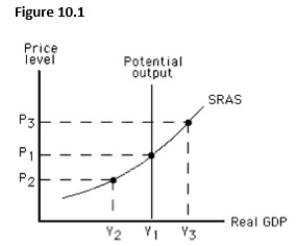
A)there is an expansionary gap.
B)the price level will decrease.
C)the actual unemployment rate is equal to the natural unemployment rate.
D)the actual unemployment rate is below the natural unemployment rate.
E)the actual rate of output is more than the potential output.

A)there is an expansionary gap.
B)the price level will decrease.
C)the actual unemployment rate is equal to the natural unemployment rate.
D)the actual unemployment rate is below the natural unemployment rate.
E)the actual rate of output is more than the potential output.

Unlock Deck
Unlock for access to all 150 flashcards in this deck.
Unlock Deck
k this deck
43
Which of the following explains the shape of the short-run aggregate supply curve?
A)The inverse relationship between the quantity supplied and the cost per
B)The direct relationship between the quantity supplied and the cost per unit
C)The direct relationship between the quantity supplied and the price level
D)The inverse relationship between quantity supplied and GDP
E)The inverse relationship between quantity supplied and the profit per unit
A)The inverse relationship between the quantity supplied and the cost per
B)The direct relationship between the quantity supplied and the cost per unit
C)The direct relationship between the quantity supplied and the price level
D)The inverse relationship between quantity supplied and GDP
E)The inverse relationship between quantity supplied and the profit per unit

Unlock Deck
Unlock for access to all 150 flashcards in this deck.
Unlock Deck
k this deck
44
Suppose the actual and expected price levels in an economy are initially equal.However,the actual price level falls eventually due to a change in economic conditions.Which of the following will occur over the long run?
A)The economy will move rightward along the short-run aggregate supply curve.
B)The economy will move leftward along the short-run aggregate supply curve.
C)The short-run aggregate supply curve will shift to the right.
D)The short-run aggregate supply curve will shift to the left.
E)The short-run aggregate supply curve will become flatter.
A)The economy will move rightward along the short-run aggregate supply curve.
B)The economy will move leftward along the short-run aggregate supply curve.
C)The short-run aggregate supply curve will shift to the right.
D)The short-run aggregate supply curve will shift to the left.
E)The short-run aggregate supply curve will become flatter.

Unlock Deck
Unlock for access to all 150 flashcards in this deck.
Unlock Deck
k this deck
45
For the aggregate demand and aggregate supply listed in schedule #2 of the table given below,the equilibrium output level and price level are:
?
Table 10.1
?
?
?
A)$7.0 and 110,respectively.
B)$6.5 and 120,respectively.
C)$6.0 and 130,respectively.
D)$5.5 and 140,respectively.
E)$5.0 and 150,respectively.
?
Table 10.1
?
?
?
A)$7.0 and 110,respectively.
B)$6.5 and 120,respectively.
C)$6.0 and 130,respectively.
D)$5.5 and 140,respectively.
E)$5.0 and 150,respectively.

Unlock Deck
Unlock for access to all 150 flashcards in this deck.
Unlock Deck
k this deck
46
The figure below shows the short-run aggregate demand and supply curves of an economy.If the economy is currently producing at Y2,long-run equilibrium will most likely be established by a(n):
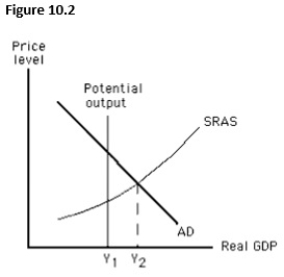
A)increase in short-run aggregate supply.
B)decrease in short-run aggregate supply.
C)decrease in potential output.
D)increase in potential output.
E)rightward shift of the aggregate demand curve.

A)increase in short-run aggregate supply.
B)decrease in short-run aggregate supply.
C)decrease in potential output.
D)increase in potential output.
E)rightward shift of the aggregate demand curve.

Unlock Deck
Unlock for access to all 150 flashcards in this deck.
Unlock Deck
k this deck
47
The figure below shows the short-run aggregate supply curve of an economy.In this figure,a recessionary gap would be represented by the distance between:
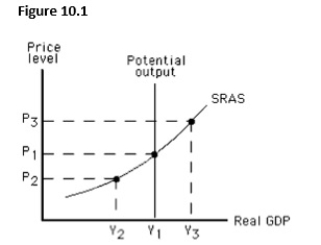
A)Y1and Y2.
B)Y1and Y3.
C)Y2and Y3.
D)P3and P1.
E)P3and P2.

A)Y1and Y2.
B)Y1and Y3.
C)Y2and Y3.
D)P3and P1.
E)P3and P2.

Unlock Deck
Unlock for access to all 150 flashcards in this deck.
Unlock Deck
k this deck
48
An expansionary gap in the short-run results in:
A)lower resource prices in the long run.
B)unemployment in the long run.
C)a recessionary gap in the long run.
D)cost-push inflation in the long run.
E)demand-pull inflation in the long run.
A)lower resource prices in the long run.
B)unemployment in the long run.
C)a recessionary gap in the long run.
D)cost-push inflation in the long run.
E)demand-pull inflation in the long run.

Unlock Deck
Unlock for access to all 150 flashcards in this deck.
Unlock Deck
k this deck
49
In the aggregate demand-aggregate supply model,which of these changes is most likely when the cost of production increases in the long run?
A)A leftward shift of the short-run aggregate supply curve
B)A leftward shift of the short-run aggregate demand curve
C)A rightward shift of the short-run aggregate supply curve
D)An increase in the potential output level increases.
E)A decrease in the actual price level decreases.
A)A leftward shift of the short-run aggregate supply curve
B)A leftward shift of the short-run aggregate demand curve
C)A rightward shift of the short-run aggregate supply curve
D)An increase in the potential output level increases.
E)A decrease in the actual price level decreases.

Unlock Deck
Unlock for access to all 150 flashcards in this deck.
Unlock Deck
k this deck
50
Suppose the actual and expected price levels in an economy are initially equal.However,the actual price level becomes higher due to some change in economic conditions.Which of the following will occur eventually?
A)The economy will move rightward along the short-run aggregate supply curve.
B)The economy will move leftward along the short-run aggregate supply curve.
C)The short-run aggregate supply curve will shift to the right.
D)The short-run aggregate supply curve will shift to the left.
E)The short-run aggregate supply curve will become flatter.
A)The economy will move rightward along the short-run aggregate supply curve.
B)The economy will move leftward along the short-run aggregate supply curve.
C)The short-run aggregate supply curve will shift to the right.
D)The short-run aggregate supply curve will shift to the left.
E)The short-run aggregate supply curve will become flatter.

Unlock Deck
Unlock for access to all 150 flashcards in this deck.
Unlock Deck
k this deck
51
The figure below shows the short-run aggregate supply of an economy.Which of the following is likely to be true if the actual price level in this figure exceeds the expected price level?

A)Equilibrium output will be Y2 in the short run.
B)Equilibrium output will be Y1 in the short run.
C)The actual unemployment rate is below the natural rate.
D)Potential output is greater than actual output.
E)The actual price level is less than the equilibrium price level.

A)Equilibrium output will be Y2 in the short run.
B)Equilibrium output will be Y1 in the short run.
C)The actual unemployment rate is below the natural rate.
D)Potential output is greater than actual output.
E)The actual price level is less than the equilibrium price level.

Unlock Deck
Unlock for access to all 150 flashcards in this deck.
Unlock Deck
k this deck
52
For the aggregate demand and aggregate supply listed in schedule #3 of the table given below,the equilibrium output level and price level are:
?
?
Table 10.1
?
?
?
A)$7.0 and 110,respectively.
B)$6.5 and 120,respectively.
C)$6.0 and 130,respectively.
D)$5.5 and 140,respectively.
E)$5.0 and 150,respectively.
?
?
Table 10.1
?
?
?
A)$7.0 and 110,respectively.
B)$6.5 and 120,respectively.
C)$6.0 and 130,respectively.
D)$5.5 and 140,respectively.
E)$5.0 and 150,respectively.

Unlock Deck
Unlock for access to all 150 flashcards in this deck.
Unlock Deck
k this deck
53
When actual output increases the potential output,_____.
A)more resources become unemployed.
B)prices remain constant.
C)prices tend to increase.
D)nominal GDP decreases.
E)resource prices decrease.
A)more resources become unemployed.
B)prices remain constant.
C)prices tend to increase.
D)nominal GDP decreases.
E)resource prices decrease.

Unlock Deck
Unlock for access to all 150 flashcards in this deck.
Unlock Deck
k this deck
54
The figure below shows the short-run aggregate supply curve of an economy.If P3 is the price level prevailing in the economy,_____.
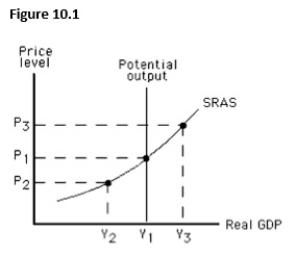
A)there is an expansionary gap.
B)there is a recessionary gap.
C)the price level will rise.
D)the actual unemployment rate is above the natural rate.
E)potential output is greater than actual output.

A)there is an expansionary gap.
B)there is a recessionary gap.
C)the price level will rise.
D)the actual unemployment rate is above the natural rate.
E)potential output is greater than actual output.

Unlock Deck
Unlock for access to all 150 flashcards in this deck.
Unlock Deck
k this deck
55
The more the short-run output exceeds an economy's potential,_____.
A)the smaller the expansionary gap
B)the greater the upward pressure on the price level
C)the larger the recessionary gap
D)the greater the downward pressure on the price level
E)the lesser the demand for resources
A)the smaller the expansionary gap
B)the greater the upward pressure on the price level
C)the larger the recessionary gap
D)the greater the downward pressure on the price level
E)the lesser the demand for resources

Unlock Deck
Unlock for access to all 150 flashcards in this deck.
Unlock Deck
k this deck
56
The figure below shows the short-run aggregate supply curve of an economy.If the actual price level exceeds the expected price level,then:
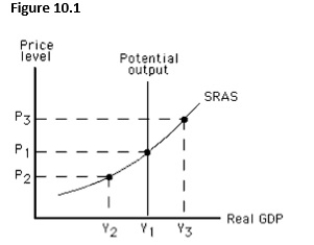
A)equilibrium output is likely to be Y2 in the short run.
B)equilibrium output is likely to be Y1 in the short run.
C)equilibrium output is likely to be Y3 in the short run.
D)potential output is greater than actual output.
E)unemployment is above the natural rate.

A)equilibrium output is likely to be Y2 in the short run.
B)equilibrium output is likely to be Y1 in the short run.
C)equilibrium output is likely to be Y3 in the short run.
D)potential output is greater than actual output.
E)unemployment is above the natural rate.

Unlock Deck
Unlock for access to all 150 flashcards in this deck.
Unlock Deck
k this deck
57
The long run is the period of time during which:
A)real wage is exactly equal to nominal wage.
B)inflation is zero.
C)excess aggregate demand leads to a shortage.
D)real wages are constant.
E)all resource prices can be varied.
A)real wage is exactly equal to nominal wage.
B)inflation is zero.
C)excess aggregate demand leads to a shortage.
D)real wages are constant.
E)all resource prices can be varied.

Unlock Deck
Unlock for access to all 150 flashcards in this deck.
Unlock Deck
k this deck
58
The figure below shows the short-run aggregate supply curve of an economy.In this figure,an expansionary gap would be represented by the distance between:
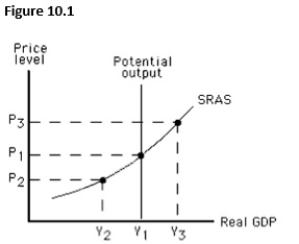
A)Y2and Y1.
B)Y3and Y1.
C)Y2and Y3.
D)P2and P1.
E)P2and P3.

A)Y2and Y1.
B)Y3and Y1.
C)Y2and Y3.
D)P2and P1.
E)P2and P3.

Unlock Deck
Unlock for access to all 150 flashcards in this deck.
Unlock Deck
k this deck
59
An expansionary gap is equal to:
A)real GDP minus nominal GDP.
B)nominal GDP minus real GDP.
C)the actual short-run output minus potential output.
D)the actual price level minus expected price level.
E)the actual long-run real GDP minus actual short-run disposable income.
A)real GDP minus nominal GDP.
B)nominal GDP minus real GDP.
C)the actual short-run output minus potential output.
D)the actual price level minus expected price level.
E)the actual long-run real GDP minus actual short-run disposable income.

Unlock Deck
Unlock for access to all 150 flashcards in this deck.
Unlock Deck
k this deck
60
In the short run,there is a positive relationship between:
A)inflation and unemployment.
B)inflation and real GDP.
C)the actual price level and the aggregate quantity supplied.
D)the actual price level and unemployment.
E)the actual price level and consumption spending.
A)inflation and unemployment.
B)inflation and real GDP.
C)the actual price level and the aggregate quantity supplied.
D)the actual price level and unemployment.
E)the actual price level and consumption spending.

Unlock Deck
Unlock for access to all 150 flashcards in this deck.
Unlock Deck
k this deck
61
The figure below shows short-run equilibrium in an aggregate demand-aggregate supply model.If the economy is currently producing Y1 level of output,long-run equilibrium will be established if:

A)the short-run aggregate supply curve shifts to the right to remove the expansionary gap.
B)the short-run aggregate supply curve shifts to the left to remove the expansionary gap.
C)the short-run aggregate supply curve shifts to the left to remove the recessionary gap.
D)the short-run aggregate supply curve shifts to the right to remove the recessionary gap.
E)there is a leftward shift of the aggregate demand curve.

A)the short-run aggregate supply curve shifts to the right to remove the expansionary gap.
B)the short-run aggregate supply curve shifts to the left to remove the expansionary gap.
C)the short-run aggregate supply curve shifts to the left to remove the recessionary gap.
D)the short-run aggregate supply curve shifts to the right to remove the recessionary gap.
E)there is a leftward shift of the aggregate demand curve.

Unlock Deck
Unlock for access to all 150 flashcards in this deck.
Unlock Deck
k this deck
62
An expansionary gap is closed in the long run by a(n):
A)rightward shift of the short-run aggregate supply curve.
B)leftward shift of the short-run aggregate supply curve.
C)movement to the right along a fixed short-run aggregate supply curve.
D)increase in aggregate demand.
E)decrease in aggregate demand.
A)rightward shift of the short-run aggregate supply curve.
B)leftward shift of the short-run aggregate supply curve.
C)movement to the right along a fixed short-run aggregate supply curve.
D)increase in aggregate demand.
E)decrease in aggregate demand.

Unlock Deck
Unlock for access to all 150 flashcards in this deck.
Unlock Deck
k this deck
63
The figure below shows short-run equilibrium in an aggregate demand-aggregate supply model.If the economy is currently producing Y1 level of output,_____.
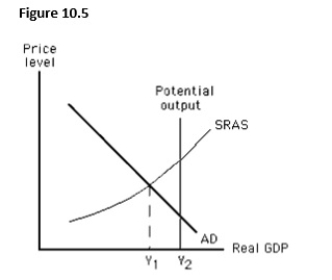
A)potential output is less than actual output.
B)there is zero unemployment.
C)the price level will rise eventually.
D)aggregate supply will fall to restore equilibrium.
E)the actual unemployment rate is more than the natural rate.

A)potential output is less than actual output.
B)there is zero unemployment.
C)the price level will rise eventually.
D)aggregate supply will fall to restore equilibrium.
E)the actual unemployment rate is more than the natural rate.

Unlock Deck
Unlock for access to all 150 flashcards in this deck.
Unlock Deck
k this deck
64
Which of the following occurs when an expansionary gap is closed in the long run by the action of firms?
A)Output decreases,and the price level increases.
B)Inflation decreases,and unemployment rises.
C)Both the equilibrium output and the price level increase.
D)Both the equilibrium output and the price level decrease.
E)Inflation rises,and unemployment decreases
A)Output decreases,and the price level increases.
B)Inflation decreases,and unemployment rises.
C)Both the equilibrium output and the price level increase.
D)Both the equilibrium output and the price level decrease.
E)Inflation rises,and unemployment decreases

Unlock Deck
Unlock for access to all 150 flashcards in this deck.
Unlock Deck
k this deck
65
The figure below shows equilibrium in an aggregate demand-aggregate supply model.Which of these statements is true if the economy described by this figure is at point M on SRAS100?
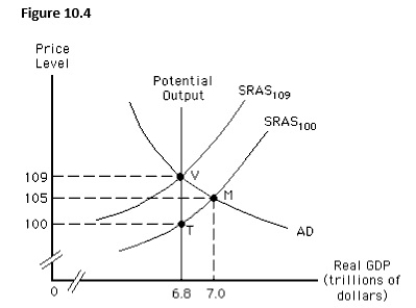
A)The actual price level is lower than expected with a $200 billion expansionary gap.
B)The actual price level is lower than expected with a $200 billion recessionary gap.
C)The actual price level is higher than expected with a $200 billion recessionary gap.
D)The actual price level is higher than expected with a $200 billion expansionary gap.
E)The economy is in equilibrium in the short run and the long run.

A)The actual price level is lower than expected with a $200 billion expansionary gap.
B)The actual price level is lower than expected with a $200 billion recessionary gap.
C)The actual price level is higher than expected with a $200 billion recessionary gap.
D)The actual price level is higher than expected with a $200 billion expansionary gap.
E)The economy is in equilibrium in the short run and the long run.

Unlock Deck
Unlock for access to all 150 flashcards in this deck.
Unlock Deck
k this deck
66
If resource suppliers and demanders find out that the actual price level exceeds the expected price level,they will take corrective actions that will:
A)cause the economy to move away from the potential output level.
B)raise the unemployment level above the natural rate of unemployment.
C)shift the aggregate demand curve of an economy.
D)shift the short-run aggregate supply curve of an economy.
E)lower the actual price level.
A)cause the economy to move away from the potential output level.
B)raise the unemployment level above the natural rate of unemployment.
C)shift the aggregate demand curve of an economy.
D)shift the short-run aggregate supply curve of an economy.
E)lower the actual price level.

Unlock Deck
Unlock for access to all 150 flashcards in this deck.
Unlock Deck
k this deck
67
If the expected price level exceeds the actual price level in an economy,_____.
A)firms increase production in the short run
B)firms decrease production in the short run
C)firms maintain production in the short run but increase prices
D)firms maintain production in the short run but decrease prices
E)firms raise prices in the short run.
A)firms increase production in the short run
B)firms decrease production in the short run
C)firms maintain production in the short run but increase prices
D)firms maintain production in the short run but decrease prices
E)firms raise prices in the short run.

Unlock Deck
Unlock for access to all 150 flashcards in this deck.
Unlock Deck
k this deck
68
The figure below shows the short-run aggregate demand and supply curves of an economy.In this figure,the distance between Y1 and Y2 represents:
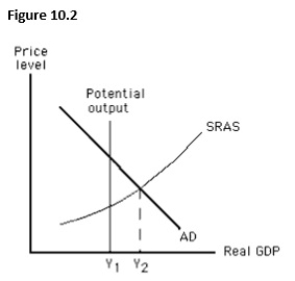
A)an expansionary gap.
B)a recessionary gap.
C)a cost-push inflation.
D)the natural rate of unemployment.
E)the full employment output.

A)an expansionary gap.
B)a recessionary gap.
C)a cost-push inflation.
D)the natural rate of unemployment.
E)the full employment output.

Unlock Deck
Unlock for access to all 150 flashcards in this deck.
Unlock Deck
k this deck
69
The figure below shows the equilibrium in an aggregate demand-aggregate supply model.In this figure,which of the following is true for an economy that is at point V in the short run?
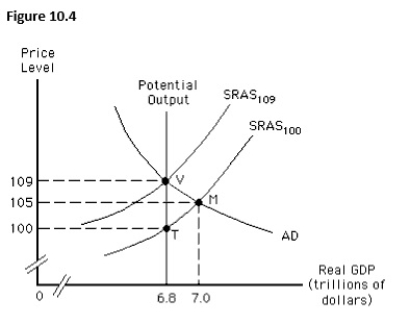
A)There is a recessionary gap worth $200 billion.
B)The potential output is $7 trillion.
C)The actual price level is 100.
D)The natural rate of unemployment is more than 6.8 trillion.
E)The actual output is equal to the potential output.

A)There is a recessionary gap worth $200 billion.
B)The potential output is $7 trillion.
C)The actual price level is 100.
D)The natural rate of unemployment is more than 6.8 trillion.
E)The actual output is equal to the potential output.

Unlock Deck
Unlock for access to all 150 flashcards in this deck.
Unlock Deck
k this deck
70
The figure below shows equilibrium in an aggregate demand-aggregate supply model.In this figure,the shift from AS to AS' is likely to occur when:
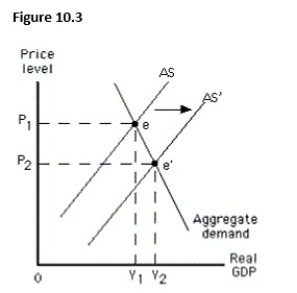
A)the actual price level is higher than expected.
B)the actual price level is lower than expected.
C)the unemployment rate is lower than the natural rate.
D)the actual output is more than the potential output.
E)the aggregate demand curve intersects the short-run aggregate supply curve at the potential output.

A)the actual price level is higher than expected.
B)the actual price level is lower than expected.
C)the unemployment rate is lower than the natural rate.
D)the actual output is more than the potential output.
E)the aggregate demand curve intersects the short-run aggregate supply curve at the potential output.

Unlock Deck
Unlock for access to all 150 flashcards in this deck.
Unlock Deck
k this deck
71
The figure below shows equilibrium in an aggregate demand-aggregate supply model.Which of these situations will be experienced by the economy as it moves from point e to point e'?
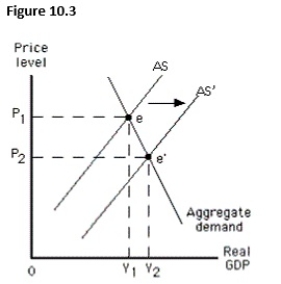
A)An expansionary gap
B)A decline in potential GDP
C)Overutilization of resources
D)Deflation
E)Cost-push inflation

A)An expansionary gap
B)A decline in potential GDP
C)Overutilization of resources
D)Deflation
E)Cost-push inflation

Unlock Deck
Unlock for access to all 150 flashcards in this deck.
Unlock Deck
k this deck
72
The figure below shows short-run equilibrium in an aggregate demand-aggregate supply model.In this figure,the distance between points Y1 and Y2 represents:
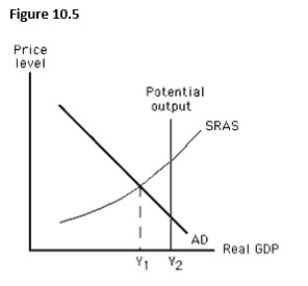
A)an expansionary gap.
B)a recessionary gap.
C)the potential output.
D)seasonal unemployment.
E)structural unemployment.

A)an expansionary gap.
B)a recessionary gap.
C)the potential output.
D)seasonal unemployment.
E)structural unemployment.

Unlock Deck
Unlock for access to all 150 flashcards in this deck.
Unlock Deck
k this deck
73
Which of the following is true of an expansionary gap?
A)It develops when the expected price level exceeds the actual price level.
B)In the long run,this gap will close when resource suppliers negotiate lower resource payments.
C)It measures the amount by which actual output falls short of the economy's potential.
D)In the long run,this gap will close when the short-run aggregate supply curve shifts rightward.
E)In the long run,this gap will close when resource suppliers negotiate higher resource payments.
A)It develops when the expected price level exceeds the actual price level.
B)In the long run,this gap will close when resource suppliers negotiate lower resource payments.
C)It measures the amount by which actual output falls short of the economy's potential.
D)In the long run,this gap will close when the short-run aggregate supply curve shifts rightward.
E)In the long run,this gap will close when resource suppliers negotiate higher resource payments.

Unlock Deck
Unlock for access to all 150 flashcards in this deck.
Unlock Deck
k this deck
74
The figure below shows equilibrium in an aggregate demand-aggregate supply model.Which of the following will be true of an economy in the long run that is at point M in the short run?
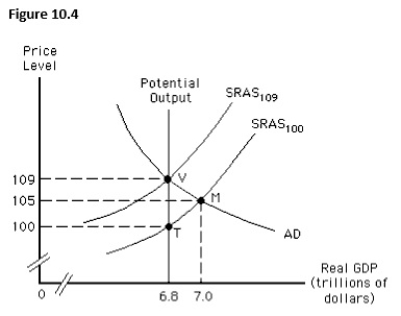
A)The actual price level will be lower than the expected price level.
B)The actual output will fall short of the potential output.
C)The short-run aggregate supply curve will remain stable at SRAS100.
D)The short-run aggregate supply curve will shift to SRAS109.
E)Real GDP will be equal to nominal GDP.

A)The actual price level will be lower than the expected price level.
B)The actual output will fall short of the potential output.
C)The short-run aggregate supply curve will remain stable at SRAS100.
D)The short-run aggregate supply curve will shift to SRAS109.
E)Real GDP will be equal to nominal GDP.

Unlock Deck
Unlock for access to all 150 flashcards in this deck.
Unlock Deck
k this deck
75
Which of these does not hold true if an economy is simultaneously in long-run and short-run equilibrium?
A)The actual price level equals the expected price level.
B)Aggregate quantity supplied equals potential output.
C)Aggregate quantity demanded equals potential output.
D)Aggregate quantity supplied equals aggregate quantity demanded.
E)Aggregate demand curve is horizontal at the potential output level.
A)The actual price level equals the expected price level.
B)Aggregate quantity supplied equals potential output.
C)Aggregate quantity demanded equals potential output.
D)Aggregate quantity supplied equals aggregate quantity demanded.
E)Aggregate demand curve is horizontal at the potential output level.

Unlock Deck
Unlock for access to all 150 flashcards in this deck.
Unlock Deck
k this deck
76
Which of the following if true would suggest that an expansionary gap exists in an economy?
A)Rapid inflation during a period when plant capacity utilization is below average
B)A steady price level coupled with a 5 percent unemployment rate
C)An unemployment rate below its natural rate and an unexpected increase in the consumer price index
D)Sluggish growth in the rate of inflation and an exceptional increase in the Dow Jones average
E)A modest increase in the number of new unemployment claims and a lower than expected price level
A)Rapid inflation during a period when plant capacity utilization is below average
B)A steady price level coupled with a 5 percent unemployment rate
C)An unemployment rate below its natural rate and an unexpected increase in the consumer price index
D)Sluggish growth in the rate of inflation and an exceptional increase in the Dow Jones average
E)A modest increase in the number of new unemployment claims and a lower than expected price level

Unlock Deck
Unlock for access to all 150 flashcards in this deck.
Unlock Deck
k this deck
77
The figure below shows equilibrium in an aggregate demand-aggregate supply model.The shift from AS to AS' in this figure represents a(n):
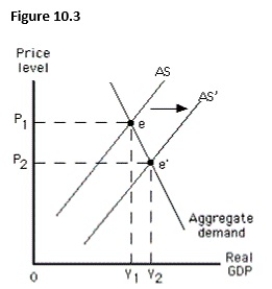
A)increase in short-run aggregate supply.
B)increase in long-run aggregate supply.
C)decrease in short-run aggregate supply.
D)decrease in long-run aggregate supply.
E)decrease in the aggregate quantity demanded.

A)increase in short-run aggregate supply.
B)increase in long-run aggregate supply.
C)decrease in short-run aggregate supply.
D)decrease in long-run aggregate supply.
E)decrease in the aggregate quantity demanded.

Unlock Deck
Unlock for access to all 150 flashcards in this deck.
Unlock Deck
k this deck
78
The figure below shows the short-run aggregate demand and supply curves of an economy.When real GDP is at Y2,_____.
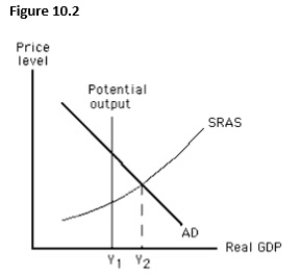
A)potential output is greater than actual output.
B)there is a recessionary gap.
C)the price level is likely to fall.
D)the actual unemployment rate is less than the natural rate of unemployment.
E)aggregate demand is likely to increase to restore equilibrium.

A)potential output is greater than actual output.
B)there is a recessionary gap.
C)the price level is likely to fall.
D)the actual unemployment rate is less than the natural rate of unemployment.
E)aggregate demand is likely to increase to restore equilibrium.

Unlock Deck
Unlock for access to all 150 flashcards in this deck.
Unlock Deck
k this deck
79
The amount by which actual output falls short of potential output is called:
A)a deadweight loss.
B)real GDP.
C)a recessionary gap.
D)the full-employment output.
E)an expansionary gap.
A)a deadweight loss.
B)real GDP.
C)a recessionary gap.
D)the full-employment output.
E)an expansionary gap.

Unlock Deck
Unlock for access to all 150 flashcards in this deck.
Unlock Deck
k this deck
80
As actual output falls below the potential level in the short run,which of the following is most likely to occur?
A)More resources will become unemployed.
B)The price level will increase.
C)Real GDP will increase.
D)Nominal GDP will remain constant.
E)The natural rate of unemployment will fall.
A)More resources will become unemployed.
B)The price level will increase.
C)Real GDP will increase.
D)Nominal GDP will remain constant.
E)The natural rate of unemployment will fall.

Unlock Deck
Unlock for access to all 150 flashcards in this deck.
Unlock Deck
k this deck



